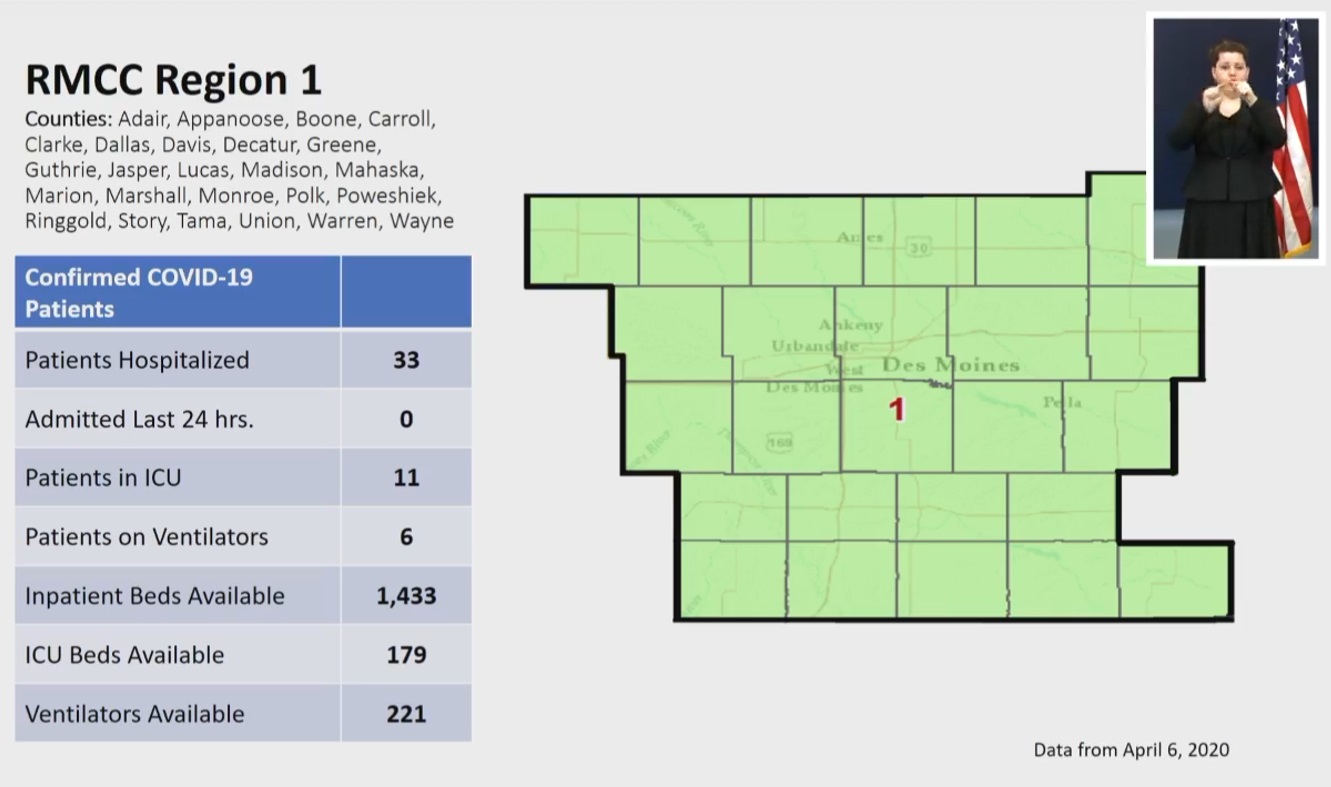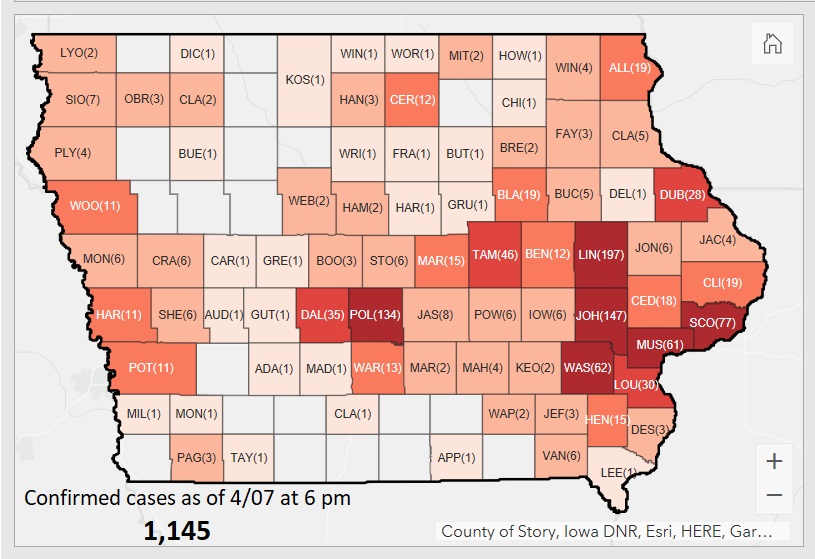~by Victoria Riley, GreeneCountyNewsOnline
Iowa is still lacking in personal protective equipment (PPE) for healthcare providers, but the state is in good shape for other resources, according to Iowa Department of Public Health deputy director Sarah Reisetter.
“The PPE shortages are real,” she said during Gov Kim Reynolds’ press conference Wednesday (April 8). IDPH is continuing to “look for PPE from all different avenues,” including Iowa manufacturers that have begun producing PPE.
“We feel pretty good from a resource standpoint in terms of beds and ventilators at this particular time, based on what we’re seeing, but again, critical to all of this, is that it really is important for all Iowans to continue to stay home, leave only for essentials. That’s the way we’re going to slow the spread of the virus in our state and make sure that our hospitals and our health systems have the capacity to deal with our patients that do need hospitalization,” Reisetter said.
According to IDPH, 97 new cases of COVID-19 were identified during the 24 hours ending April 7 at 6 pm, bringing the total to 1,145 positive cases. There have been an additional 1,151 negative tests for a total of 12,821 negative tests to date, which includes testing reported by the State Hygienic Lab and other labs.
One additional death was reported during that time – a resident of Linn County who was older than 81 years. (Scroll to the end of this post for more information about the new cases.
The governor shared more detailed information about the Regional Medical Coordination Center (RMCC) that includes Greene County – Region 1. The Iowa National Guard, in conjunction with the IDPH and the Iowa Healthcare Coalition, provides support, including resource management, through the RMCCs.
In Region 1, as of April 7, there were 33 COVID-19 patients hospitalized, 11 of whom are in intensive care units, with six of them on ventilators. There are a total of 179 more ICU beds and 221 more ventilators “available and ready for patient care,” Reynolds said.
The National Guard will move equipment or patients will be transferred to other regions if the need arises.
Reynolds’ prepared statement focused on the efforts of the Iowa Economic Development Authority (IEDA) to assist owners of small businesses. The IEDA received nearly 14,000 applications for grants from the Small Business Relief program with at least 15 from every county. More than $148 million was requested.
The program originated with $4 million. Reynolds on April 8 expanded the program to $24 million.
The first round of funding was approved April 7, with assistance for owners of restaurants, bars and breweries that have been impacted by the pandemic. Those businesses were among the first to be closed by the governor.
IEDA director Debi Durham spoke at the press conference. “Our small businesses are the backbone of our communities, and we’re working closely with the governor to leverage resources to assist as many of them as possible,” Durham said.
Durham said 503 business owners received word Tuesday they’ve been approved for the Small Business Relief program. A total of $10 million was awarded in amounts from $5,000 to $25,000, with the awards going to those who saw the largest revenue disruption due to the closures.
Notifications of approval will also be sent Wednesday and Thursday. Those who don’t receive notification of funding this week will be eligible for funding as it becomes available in the future.
Reynolds learned just today that Iowa will receive $1.25 billion in the $2 trillion federal CARES (Coronavirus Aid, Relief, and Economic Security) Act. A portion of that will be distributed by the IEDA.
Reynolds was asked during the Q & A portion of the press conference about her plans for Iowa schools.
Administrators and teachers in the Greene County and Paton-Churdan districts are working to develop voluntary continuous learning programs to fill in the two weeks from April 13 to April 30, an extension of Reynolds’ first statewide school closure due to the COVID-19 pandemic.
Wednesday morning the Des Moines Public Schools, the largest district in the state, announced it would finish the school year using distance learning. The schools will not re-open to students until August.
Reynolds said she would give school districts two weeks’ notice of a change to the May 1 date for resuming school. That sets the next decision for April 16. “We’ll sit down and look at the data and give them (school districts) some idea which direction we’re recommending they go,” she said.
She added that her office and the Department of Education have asked every district to let them know what their needs are, whether it be broadband internet or more devices for students. “If there are things that you need that are preventing you from providing that education for your students, let us know and we’ll see what we can do… There are a lot of things we’re looking at. People have been very creative and innovative. We want to make sure we’re providing continuous education to our students. That’s extremely important and the state will have a role to play.”
—–
According to IDPH, the locations and age ranges of the 97 individuals newly identified has having COVID-19 include:
• Allamakee County, 1 adult (18-40 years), 1 older adult (61-80 years)
• Benton County, 1 child (0-17 years)
• Black Hawk County, 1 adult (18-40 years), 3 middle-age adults (41-60 years)
• Cedar County, 3 adults (18-40 years), 1 older adult (61-80 years)
• Clinton County, 1 adult (18-40 years), 1 middle-age adult (41-60 years)
• Crawford County, 1 adult (18-40 years)
• Harrison County, 1 adult (18-40 years)
• Henry County, 2 adults (18-40 years)
• Johnson County, 10 adults (18-40 years), 1 middle-age adult (41-60 years), 2 older adult (61-80 years)
• Linn County, 1 child (0-17 years), 4 adults (18-40 years), 1 middle-age adult (41-60 years), 3 older adults (61-80 years), 2 elderly adults (81+)
• Louisa County, 4 adults (18-40 years), 5 middle-age adults (41-60 years), 1 older adult (61-80 years)
• Marshall County, 1 adult (18-40 years)
• Muscatine County, 4 adults (18-40 years), 5 middle-age adults (41-60 years), 1 older adult (61-80 years)
• Polk County, 2 adults (18-40 years), 4 middle-age adults (41-60 years), 1 older adult (61-80 years)
• Pottawattamie County, 1 middle-age adult (41-60 years), 1 older adult (61-80 years)
• Scott County, 4 adults (18-40 years), 7 middle-age adults (41-60 years), 1 older adult (61-80 years)
• Tama County, 1 adult (18-40 years), 1 middle-age adult (41-60 years), 2 older adults (61-80 years)
• Warren County, 1 elderly adult (81+)
• Washington County, 3 adults (18-40 years), 1 middle-age adult (41-60 years), 1 older adult (61-80 years)
• Webster County, 1 older adult (61-80 years)
• Woodbury County, 2 middle-age adults (41-60 years)
• Worth County, 1 middle-age adult (41-60 years)
